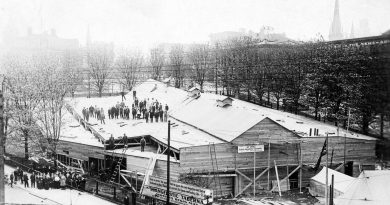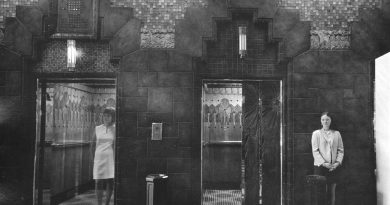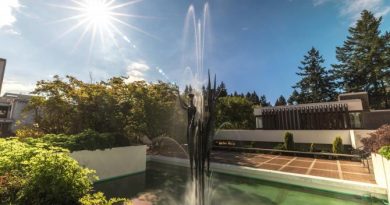1943
Above: Women’s Ambulance Corps [Vancouver Unit]
[Image: Vancouver City Archives AM1545-S3-: CVA 586-2348]
*****************************************
You’ll note that these years include events listed under “Also in . . .” These are events for which we don’t have a specific date. If YOU know the specific date of an event shown there, please notify us . . . and cite the source! Many thanks!
*****************************************
January 1 The sale of whipping cream was forbidden in British Columbia, a result of World War II rationing restrictions.
January 4 Effective this date boys who had reached the age of 17 were allowed to enlist for training in active units or formations of the Canadian Army. They were paid 70 cents per day.
January 6 Future premier Mike Harcourt was born in Edmonton, Alberta.
January 18 Vancouver-based writer Daniel Wood was born.
March 2 RAF/RCAF war ace “Buzz” Beurling, “King of the Air over Malta,” visited Vancouver. For a fascinating look at his career (he wasn’t your everyday war hero!), and lots of photographs, see this site.
March 5 Broadcasting executive Ted Smith was born.
March 18 Construction began on the Fort Columbia, first of the Victory ships to be built by Burrard Dry Dock. With oil-fired boilers they were cheaper to run than coal-fired North Sands ships, although some Victory ships were built to run on either. The company will build 34 of the Second World War ships in a little over two years.
Edelweiss Credit Union was established in Vancouver to serve the area’s German community. It eventually became part of Prospera Credit Union.
March 31 Oklahoma! premieres on Broadway.
March Construction began on the last North Sands ship. It will take three-and-a-half months. When Burrard Dry Dock laid the keel of the SS Fort St. James, the first of its North Sands 10,000-ton cargo vessels, on April 23, 1941 it took nine months to complete. Despite thousands of workers new to the ship-building industry, mass production techniques quickly enabled the formation of an efficient workforce.
Also March The canoe called Houmiltichesen, built by Jericho Charlie (Chin-nal-set), was presented as a gift to the City of Vancouver by the B.C. Loggers’ Association and the Consolidated Red Cedar Shingle Association of B.C. They had purchased it from August Jack Khatsahlano, his stepson.
May 3 From the Province, Page 6:
“City police Sunday seized two cameras and a quantity of film from persons taking photographs in prohibited waterfront areas.
“A Lt.-Cdr. of the U.S. Navy lost his camera and film when he was stopped by police at Prospect Point in Stanley Park.
“Two girls, photographing each other at the North Vancouver ferry wharf, were required to turn over their picture-taking equipment.
“A man reported to be taking pictures of English Bay from Queen Mary School grounds, Fourth and Trimble, could not be found when police searched the district Sunday.”
May 11 Olympic skiing champion Nancy Greene was born in Ottawa.
May 15 Six paintings by Emily Carr went on sale at an exhibition of works by Carr and others at the 33rd Annual Exhibition of the B.C. Society of Fine Arts at the Vancouver Art Gallery. The Carrs were priced at $50 each.
June 6 Theatre director Bill Millerd was born in West Vancouver.
June 13 Sir Gerald Burrard, a descendant of Harry Burrard, the friend of George Vancouver after whom Burrard Inlet was named, presented a telescope to the city. (Gerald Burrard is famous for his knowledge of weaponry. He has written on shotguns, etc.)
June 26 The cornerstone was laid for HMCS Discovery on Deadman’s Island, Stanley Park. For pictures and stories of Discovery and other Vancouver-based military locations, see this site.
June Burnaby endorsed a “closed shop” for civic employees—the third municipality in Canada to do so, and the first in B.C. (A closed shop is one in which the employer hires only union members in good standing.)
July 6 Cinematographer Bob Asgeirsson was born.
July 14 Langley Memorial Hospital was incorporated.
July Canadian mining tycoon Sir Harry Oakes was murdered in the Bahamas.
August 19 First annual exhibition of the Vancouver Gladiolus Society.
August 25 At rededication ceremonies in Stanley Park, the official party was driven by Frank Plant, who had driven Lord and Lady Stanley and Mayor and Mrs. Oppenheimer to the original dedication 55 years earlier! The 1889 ceremony was re-created at the same spot. Playing the role of Mayor David Oppenheimer was his great-nephew David Oppenheimer . . . of Oppenheimer Brothers!
September 3 Italy surrendered.
September 8 Southam bought the Vancouver Daily Province.
September 13 The West Vancouver Parks Board was established.
Also September 13 Broadcaster, videographer Jim Morrison was born.
September 23 A great news item appeared in the Province: “When Mr. and Mrs. E. R. Valleau purchased a home on Burke Street in Burnaby they proceeded to build a home. That was last February. Just the other day when Mr. J. H. Treaves purchased a lot, he discovered he owned the Valleau home. Arrangements for the transfer are being completed, and Mr. and Mrs. Valleau will soon have title to their home. They had mistakenly built their home on the adjoining piece of property.”
October 4 Frederick William Howay (born Howie), judge and historian, died in New Westminster, aged 75. He was born November 25, 1867 in London, Ont. His father moved to B.C. in 1869, was joined by his wife and three children in 1870. Frederick practised law, becoming a county court judge (1907-37). He wrote books and articles establishing him as the leading B.C. historian of his generation. He was president of the Art, Historical and Scientific Association of Vancouver (1910-15), a precursor of the Vancouver Museum. He was a member for 20 years (1923 to his death) of the Historic Sites and Monuments Board of Canada, and a UBC senator from 1915 to 1942. His British Columbia From Earliest Times to the Present (1914) was the standard history of B.C. into the 1950s.
October 6 Vancouver’s water supply was chlorinated.
October 21 England-born Percy W. Evans, cement and fuel supplier, died in Los Angeles, Calif. “With his brother Ernest and cousin George Coleman,” Constance Brissenden writes, “he came to B.C. from England in 1888. The trio opened a fuel and cement firm, Evans, Coleman and Evans, on Columbia Street. They built the city’s first deep-sea dock. They sold the firm in 1910 to a group of prominent business people including William Farrell and Frank Barnard. With his brother, Percy also owned Vancouver’s Stanley and Manitoba hotels with interest in the Plaza Theatre building. He was a director of B.C. Telephone and other communications concerns.”
November 11 After being silent for some time because of wartime shortages, Vancouver’s famous Nine O’Clock Gun resumed firing. There were a few more days of silence, then it was back to regular operation.
November 13 Newspapers reported that the Dominion Bank Building, the 15-storey office structure at the northwest corner of Cambie and Hastings, had been purchased by Samuel J. Cohen, president of the Army & Navy Department Stores Ltd., and would be remodelled as a modern department store after the war. Wonder whatever happened to that idea? (Samuel Cohen’s granddaughter, Jacqui Cohen, says that it was never intended to be a department store. “He bought it because the price was right.”)
December 25 Edmund Shorey Knowlton, pioneer druggist, died in Vancouver, aged about 75. He was born c. 1868 in Newboro, Ont., came to B.C. in 1896. He opened Knowlton’s Drug Store in 1897, moved to a succession of sites on Westminster (now Main St.) and Hastings until settling in in 1911 at 15 E. Hastings. Knowlton’s opened a second drug store in West Vancouver by 1948. In 1965, the name was changed to Knowlans Drugs, but its original name was restored in 1970. He served as a president of the Pharmaceutical Association of B.C. (The famous 1907 film of Vancouver shows one of the Knowlton locations.)
Also in 1943
Kitsilano Beach was used for rehearsing commando beach assaults. Still, the receding danger of attack brought a gradual reduction in local defences to release trained personnel for the Canadian Army in Europe, which was now in continuous action.
Burnaby Hospital had a humble beginning. A group of Burnaby citizens interested in building a local hospital met and formed a fund-raising committee; $6,000 was raised by door-to-door canvass. That prompted the city to provide more funds and the hospital was on its way. (Burnaby’s population at the time was 35,000 and average weekly wage was $33.81).
The Vancouver Foundation was established. The key figure in its creation was W. J. VanDusen, lumber magnate and philanthropist. Whitford Julian VanDusen came from Tara, Ontario where he was born July 18, 1889. His long, solid work in the lumber industry from 1912 to 1969 (much of it beside H.R. MacMillan) is deservedly overshadowed by his remarkable philanthropy. The Vancouver Foundation now distributes about $60 million annually, and supports a wide range of issues from arts and culture, to environment, education, health and children, youth and family issues. Today it is Canada’s largest community foundation with an endowment fund worth roughly $800 million. (VanDusen also paid for and donated the land now occupied by Vancouver’s VanDusen Botanical Garden. He died here December 15, 1978.) The Foundation is the sponsor of 1943 in The History of Metropolitan Vancouver.
The Southlands Riding Club was incorporated. Today it sits on just over seven hectares in the heart of the community. The clubhouse, once an abandoned fisherman’s net storage hut on Deering Island, was dismantled and carried piece by piece, by members on horseback, to its present site.
Victor Odlum, 62, soldier and newspaper publisher, was named Canada’s first ambassador to China. He served to 1946.
Hockey’s Lynn Patrick joined the New York Rangers, coached by his father Lester Patrick, and scored 13 goals in his first season.
H.R. Butler was club champion this year of the old Shaughnessy Golf Club.
Toronto-born Elmore Philpott, 47, joined the Vancouver Sun, began a political affairs column that lasted to 1961.
The book The Ports of British Columbia by Agnes Rothery appeared.
“Responding to the war crisis,” Jim Lyon wrote in The Greater Vancouver Book, “Vancouver’s shipyards turned out hundreds of cargo vessels and warships and by the peak year of 1943 the work force had grown to more than 25,000. This number did not include several thousand more employed in support industries such as boilermaking and the manufacture of steering engines and winches. In just four years West Coast yards built more than three million tons of new shipping and repaired, converted and refitted a similar amount. In 1943 alone Burrard Drydock completed 33 cargo vessels, North Vancouver Ship Repairs completed 15, West Coast Ship Builders turned out 17 and the remaining yards in British Columbia launched four. The vessels, of 10,000 tons and 4,700 tons, were produced at remarkable speed, some completed in just 65 days.”
Construction began on Burkeville, west of Airport Road in Richmond. Harold Kalman, architectural historian, has written: “Burkeville was laid out and built by the federal government during the Second World War to provide 328 houses for workers employed at the Boeing Aircraft plant. It was named for Stanley Burke, president of Boeing. The streets are named after airplane manufacturers. The plain, no-frills dwellings came in several standard sizes. Most have been altered to fit the needs of two generations of residents. After the War, Boeing sold the houses to returning veterans. The tightly-knit community, already encircled by airport uses, is currently threatened by the intended further expansion of roads and runways.” Ironically, the “plain, no-frills dwellings” were designed by McCarter and Nairne, who gave us the Marine Building. The name of the development was chosen in a competition among Boeing employees.
Activities of the Ukrainian Labour-Farm Temple Association were once again allowed. In 1940 the ULFTA’s community hall at 805 East Pender in Strathcona was seized (one of 108 across the country!) because of the association’s opposition to Canadian involvement in the war. At the time, journalist Kevin Griffin has written, the ULFTA supported the Soviet Union which had yet to join the Allied effort against Nazi Germany. Now, in 1943, the ban was lifted. (In 1946, the ULFTA would change its name to the Association of United Ukrainian Canadians.)
John Henderson (1880-1968) began 21 years’ service as a Vancouver School Trustee. He would be named Vancouver’s Good Citizen in 1961 because of his long service in a score of organizations and for many personal deeds. An elementary school is named for him.
Advocate, a bimonthly published by the Vancouver Bar Association, began publication.
Vancouver artist Lutz Haufschild was born in Germany.
Sports publicist Norm Jewison (no relation to the movie director) was born in England. He grew up in Montreal and moved to Vancouver in 1977 to become public relations director for the Canucks.
The precursor of the Vancouver Volunteer Centre was formed in 1943. It was initially charged with mobilizing women for the war effort and providing accommodation for children evacuated from Britain and for those whose mothers worked on the assembly line. The Women’s Voluntary Service, as it was known at the time, began by helping 37 agencies and registering 267 volunteers. By the end of the war approximately 10,000 volunteers were involved.
Vancouver-based E.J. Ryan Contracting, one of Canada’s largest contractors, filed for bankruptcy.
On her husband R.J. Sprott’s death, Anna Ethel Sprott became president of the Sprott-Shaw Schools of Commerce, Radio and Telegraphy. She was the founder of the West Coast Radio School.

![Women's Ambulance Corps [Vancouver Unit]](https://vancouverhistory.ca/wp-content/uploads/2020/11/b2c3395a-3c9d-4179-a85a-6aed250e77bf-A14388-800x445.jpg)


